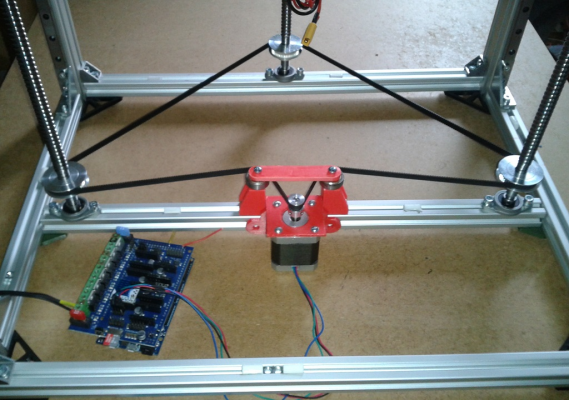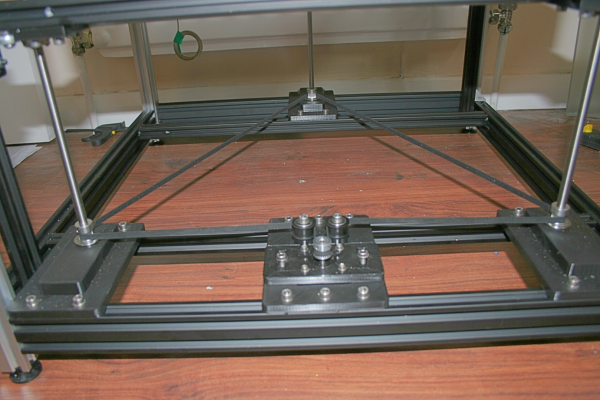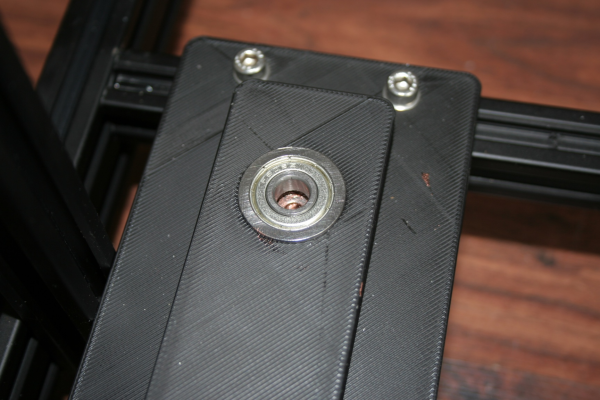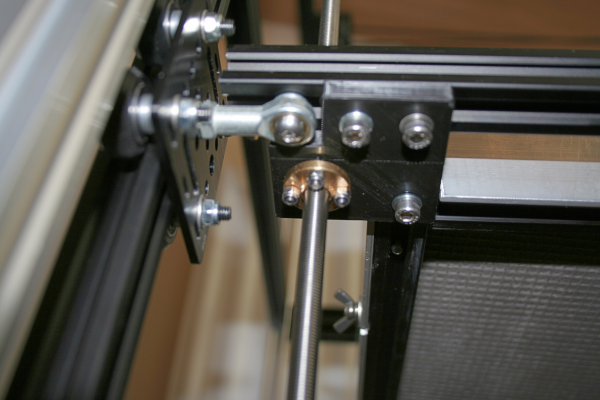Moving a heavy bed
Posted by pugzor
|
Moving a heavy bed June 03, 2017 04:18AM |
Registered: 9 years ago Posts: 164 |
Hi guys,
I'm trying to pick up a build I've begun with a large print bed using a CoreXY config.
Anyway, the one thing I'm not 100% confident about is the way I'm thinking about moving the bed vertically. I really would like to know what the best options are out there for this.The whole machine is around 750x750x750mm, so it's quite large. Original thoughts were based on the Vulcanus Max but I wanted to change a few bits and bobs like the bed design. I was considering powering it with a MKS SBASE (have a v1.2 sitting here) but that's up for debate if it's not likely to work well.
Probably the biggest concern I have is that it's quite a large format with an effective printing area of 500x500mm. I've decided to go with a milled aluminium bed (has a flatness of +-0.38mm over 6ft, apparently) which is going to be amazing, but of course the weight is going to hurt - it's about 10kg just for the aluminium. Then there's the rails under it, heat pad, and anything that I print on it. One does not simply print light items with a machine that big. I'm guessing I need to support at least 15kg and this has been built into the bearings and whatnot I've sourced.
Original thoughts were to have three leadscrews mounted at different points, all connected by a common belt, driven by a single stepper (possibly geared down somehow to provide better resolution/torque). Not sure if a short Nema23 could drive that or if my electronics are capable, but I'm willing to buy more bits if I got that wrong.
Anyway, would love to hear peoples' thoughts, experiences and hopefully I'll absorb a bit of knowledge. Thanks.
I'm trying to pick up a build I've begun with a large print bed using a CoreXY config.
Anyway, the one thing I'm not 100% confident about is the way I'm thinking about moving the bed vertically. I really would like to know what the best options are out there for this.The whole machine is around 750x750x750mm, so it's quite large. Original thoughts were based on the Vulcanus Max but I wanted to change a few bits and bobs like the bed design. I was considering powering it with a MKS SBASE (have a v1.2 sitting here) but that's up for debate if it's not likely to work well.
Probably the biggest concern I have is that it's quite a large format with an effective printing area of 500x500mm. I've decided to go with a milled aluminium bed (has a flatness of +-0.38mm over 6ft, apparently) which is going to be amazing, but of course the weight is going to hurt - it's about 10kg just for the aluminium. Then there's the rails under it, heat pad, and anything that I print on it. One does not simply print light items with a machine that big. I'm guessing I need to support at least 15kg and this has been built into the bearings and whatnot I've sourced.
Original thoughts were to have three leadscrews mounted at different points, all connected by a common belt, driven by a single stepper (possibly geared down somehow to provide better resolution/torque). Not sure if a short Nema23 could drive that or if my electronics are capable, but I'm willing to buy more bits if I got that wrong.
Anyway, would love to hear peoples' thoughts, experiences and hopefully I'll absorb a bit of knowledge. Thanks.
|
Re: Moving a heavy bed June 03, 2017 07:02AM |
Registered: 10 years ago Posts: 14,672 |
Using a single motor driving 3 leadscrews is an easy way to keep the leadscrews in sync, but then you need a single motor that is powerful enough to drive all of them. You can work out the torque needed to support a 15kg bed using ideal frictionless leadscrews like this:
Torque = (screw_lead * mass * g)/(2 * pi)
For your 15kg bed with a 4mm (= 0.004m) lead on your leadscrews (e.g. 2mm pitch 2 start), this gives:
Torque = 0.004 * 14 * 9.8 / (2 * pi) = 0.09Nm
You can find formulae that account for friction in the Mechanics section of [en.wikipedia.org].
I suggest you choose a motor with a holding torque of about 20x the calculated value, in order to get accurate movement when you send a single 1/16 or perhaps 1/8 microstep and to allow for using a little less than the full rated current. So I think you need a motor with around 1.8Nm of holding torque in this example. Here is one possibility: [www.omc-stepperonline.com].
You can reduce the required torque by using a smaller pulley on the motor than you do on the leadscrews, to provide reduction gearing..
Ordinary 3D printer electronics can't drive Nema 23 motors close to full power because their stepper drivers are limited to a maximum current in the range 1.5 to 2.0A. The exception is the Duet WiFi and Duet Ethernet (see disclosure in my signature), which can drive motors at up to 2.0A without cooling and higher values with cooling. The 2.4A limit in the current firmware would be a good match for the 2.8A motor I linked to earlier. With any other electronics, you will need to use an external high-current stepper driver to drive the Z motor.
You can reduce the torque requirement by using a separate stepper motor to drive each leadscrew. Duet users have employed a couple of mechanisms to keep the motors in sync. One is to use a separate homing switch close to each leadscrew, so when homing each motor stops when its own homing switch is triggered. The other is to use the Z probe to probe the bed close to each support point and make fine adjustments to the position of each motor. The disadvantage with both of these schemes is you need 6 stepper drivers in total, which is one more than the 5 provided. Expansion boards are available to provide an additional 2 or 5 drivers, but of course adding an expansion board increases the cost.
HTH David
Edited 4 time(s). Last edit at 06/03/2017 07:04AM by dc42.
Large delta printer [miscsolutions.wordpress.com], E3D tool changer, Robotdigg SCARA printer, Crane Quad and Ormerod
Disclosure: I design Duet electronics and work on RepRapFirmware, [duet3d.com].
Torque = (screw_lead * mass * g)/(2 * pi)
For your 15kg bed with a 4mm (= 0.004m) lead on your leadscrews (e.g. 2mm pitch 2 start), this gives:
Torque = 0.004 * 14 * 9.8 / (2 * pi) = 0.09Nm
You can find formulae that account for friction in the Mechanics section of [en.wikipedia.org].
I suggest you choose a motor with a holding torque of about 20x the calculated value, in order to get accurate movement when you send a single 1/16 or perhaps 1/8 microstep and to allow for using a little less than the full rated current. So I think you need a motor with around 1.8Nm of holding torque in this example. Here is one possibility: [www.omc-stepperonline.com].
You can reduce the required torque by using a smaller pulley on the motor than you do on the leadscrews, to provide reduction gearing..
Ordinary 3D printer electronics can't drive Nema 23 motors close to full power because their stepper drivers are limited to a maximum current in the range 1.5 to 2.0A. The exception is the Duet WiFi and Duet Ethernet (see disclosure in my signature), which can drive motors at up to 2.0A without cooling and higher values with cooling. The 2.4A limit in the current firmware would be a good match for the 2.8A motor I linked to earlier. With any other electronics, you will need to use an external high-current stepper driver to drive the Z motor.
You can reduce the torque requirement by using a separate stepper motor to drive each leadscrew. Duet users have employed a couple of mechanisms to keep the motors in sync. One is to use a separate homing switch close to each leadscrew, so when homing each motor stops when its own homing switch is triggered. The other is to use the Z probe to probe the bed close to each support point and make fine adjustments to the position of each motor. The disadvantage with both of these schemes is you need 6 stepper drivers in total, which is one more than the 5 provided. Expansion boards are available to provide an additional 2 or 5 drivers, but of course adding an expansion board increases the cost.
HTH David
Edited 4 time(s). Last edit at 06/03/2017 07:04AM by dc42.
Large delta printer [miscsolutions.wordpress.com], E3D tool changer, Robotdigg SCARA printer, Crane Quad and Ormerod
Disclosure: I design Duet electronics and work on RepRapFirmware, [duet3d.com].
|
Re: Moving a heavy bed June 03, 2017 08:24PM |
Registered: 9 years ago Posts: 164 |
David, thank you for such a comprehensive reply. You're always very informative. I remember you have suggested the Duet boards a few times in a couple of threads.
If there's a way to get multiple motors to sync, I think that would be preferred even if it comes at more expense. I'm pretty concerned about the tensioning on a very long belt driven by a single motor. Do you have any links to where people have explained this method in more detail?
I assume the Paneldue is more of a nice-to-have more than anything else if I was to go with the Duet WiFi?
If there's a way to get multiple motors to sync, I think that would be preferred even if it comes at more expense. I'm pretty concerned about the tensioning on a very long belt driven by a single motor. Do you have any links to where people have explained this method in more detail?
I assume the Paneldue is more of a nice-to-have more than anything else if I was to go with the Duet WiFi?
|
Re: Moving a heavy bed June 03, 2017 10:17PM |
Registered: 8 years ago Posts: 338 |
i don't have a panel due, the web interface is soooo nice i don't miss it  On the printer i am building now i definately will be getting a panel due though, just because. I've used ramps, then rambo, and now duet and duet is definately worth the money.
On the printer i am building now i definately will be getting a panel due though, just because. I've used ramps, then rambo, and now duet and duet is definately worth the money.
Many people use the single motor/multiple leadscrews for the z axis. You can tight up the belts with a pulley and a screw that pulls on the pulley to tighten it, I think that solving the belt tensioning problem is going to be easier that managing three stepper motors and making sure they are all in sink,
 On the printer i am building now i definately will be getting a panel due though, just because. I've used ramps, then rambo, and now duet and duet is definately worth the money.
On the printer i am building now i definately will be getting a panel due though, just because. I've used ramps, then rambo, and now duet and duet is definately worth the money.Many people use the single motor/multiple leadscrews for the z axis. You can tight up the belts with a pulley and a screw that pulls on the pulley to tighten it, I think that solving the belt tensioning problem is going to be easier that managing three stepper motors and making sure they are all in sink,
|
Re: Moving a heavy bed June 04, 2017 02:06AM |
Registered: 8 years ago Posts: 5,232 |
I took the one stepper/ three ballscrews way.
Ballscrews are highly recommended, 'cause they have way lower friction than others.
I'm using a 1.7A Nema17 for my ~3kg bed and it never misses a step ( Pulley ratio is 16/50 )
My gutt feeling tells me a 1.8A NEMA23 with the same setup and a decent driver will lift your bed anytime.
Ballscrews are highly recommended, 'cause they have way lower friction than others.
I'm using a 1.7A Nema17 for my ~3kg bed and it never misses a step ( Pulley ratio is 16/50 )
My gutt feeling tells me a 1.8A NEMA23 with the same setup and a decent driver will lift your bed anytime.
|
Re: Moving a heavy bed June 04, 2017 05:13AM |
Registered: 8 years ago Posts: 622 |
I have a single Nema 17 driving 3 leads screws lifting a 10mm thick 400mmx 400mm bed. It's this one [uk.omc-stepperonline.com]
I'd personally steer well clear of ball screws due to the course lead. Friction is a minor concerned compared to the mass involved. especially at the speeds we need to run our Z axes. In fact, course lead and low friction ball screws (which are designed for high speed linear moves) could give the situation where the bed can fall under it's own weight once power is removed from the steppers. I'd also steer well clear of multi start lead screws for the same reason (course lead). I use 8mmx 1mm pitch single start screws so the lead is 1mm. The bed is constrained from any tendency to rotate of twist by separate linear guides so the screws only provide lift. If you use 2mm lead, you'll need twice the torque, 4mm lead will require 4 times the torque (and you'll be relying on micro stepping for positional accuracy).
I'd personally steer well clear of ball screws due to the course lead. Friction is a minor concerned compared to the mass involved. especially at the speeds we need to run our Z axes. In fact, course lead and low friction ball screws (which are designed for high speed linear moves) could give the situation where the bed can fall under it's own weight once power is removed from the steppers. I'd also steer well clear of multi start lead screws for the same reason (course lead). I use 8mmx 1mm pitch single start screws so the lead is 1mm. The bed is constrained from any tendency to rotate of twist by separate linear guides so the screws only provide lift. If you use 2mm lead, you'll need twice the torque, 4mm lead will require 4 times the torque (and you'll be relying on micro stepping for positional accuracy).
|
Re: Moving a heavy bed June 04, 2017 06:24AM |
Registered: 9 years ago Posts: 164 |
@Qdeathstar, thanks, that's what I was originally thinking! Having known some people have sync'd their steppers, I'm curious though.
@o_lampe, that's amazing. I had pretty much exactly that setup in my head... How do you keep the belt tensioned though? I've got some nice leadscrews which are relatively low in friction, to the point you can put the nut on it and it'll just slide on down. Not as good as ballscrews but should still do the trick, I reckon. Out of interest, what are your leadscrews resting on? I got some ball castors (used to a fair amount of pressure) and I was going to put a mild concave end on my leadscrews.
@deckingman I'll definitely take that into consideration! Thanks!
@o_lampe, that's amazing. I had pretty much exactly that setup in my head... How do you keep the belt tensioned though? I've got some nice leadscrews which are relatively low in friction, to the point you can put the nut on it and it'll just slide on down. Not as good as ballscrews but should still do the trick, I reckon. Out of interest, what are your leadscrews resting on? I got some ball castors (used to a fair amount of pressure) and I was going to put a mild concave end on my leadscrews.
@deckingman I'll definitely take that into consideration! Thanks!
|
Re: Moving a heavy bed June 04, 2017 07:22AM |
Registered: 10 years ago Posts: 14,672 |
If you are interested in pursuing the approach of using multiple Z motors with Duet electronics, here are some relevant forum threads:
Using one homing switch per Z motor: [www.duet3d.com]
Using a Z probe to fine-tune the Z motors individually: [www.duet3d.com]
Either of these solutions requires that the joints between the leadscrew followers and the bed have a small amount of give so that the bed can tilt at small angles without stressing the leadscrews. The single motor approach is probably simpler.
Large delta printer [miscsolutions.wordpress.com], E3D tool changer, Robotdigg SCARA printer, Crane Quad and Ormerod
Disclosure: I design Duet electronics and work on RepRapFirmware, [duet3d.com].
Using one homing switch per Z motor: [www.duet3d.com]
Using a Z probe to fine-tune the Z motors individually: [www.duet3d.com]
Either of these solutions requires that the joints between the leadscrew followers and the bed have a small amount of give so that the bed can tilt at small angles without stressing the leadscrews. The single motor approach is probably simpler.
Large delta printer [miscsolutions.wordpress.com], E3D tool changer, Robotdigg SCARA printer, Crane Quad and Ormerod
Disclosure: I design Duet electronics and work on RepRapFirmware, [duet3d.com].
|
Re: Moving a heavy bed June 04, 2017 10:41AM |
Registered: 8 years ago Posts: 622 |
Here is mine if you are interested. The Z motor is underneath the front mount.
I used thrust bearings under the screws to take the downwards load with "conventional" bearings above.
The fixture to the bed allows some degree of "tilt" for levelling. I simply slacken the screws on the pulleys and rotate the lead screws to level the bed. Did it initially, then again after a month or so when everything had settled in. Never had to adjust (or use software compensation) since.
I used thrust bearings under the screws to take the downwards load with "conventional" bearings above.
The fixture to the bed allows some degree of "tilt" for levelling. I simply slacken the screws on the pulleys and rotate the lead screws to level the bed. Did it initially, then again after a month or so when everything had settled in. Never had to adjust (or use software compensation) since.
|
Re: Moving a heavy bed June 04, 2017 11:31AM |
Registered: 8 years ago Posts: 5,232 |
I'm using self aligning bearing brackets for the lower end of the ball screws. They are clamped to the shaft by two grubscrews. No extra axial bearing underneath.
To tighten the belt, I have to move the whole cross bar and realign the ballscrew nuts to the bed frame afterwards. Only had to do it once.
To tighten the belt, I have to move the whole cross bar and realign the ballscrew nuts to the bed frame afterwards. Only had to do it once.
Sorry, only registered users may post in this forum.




